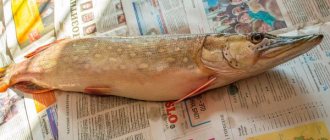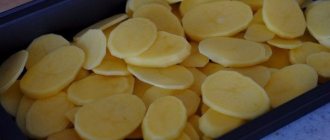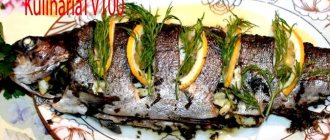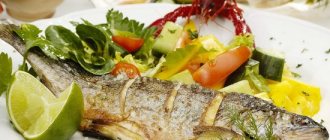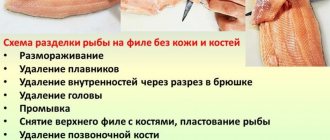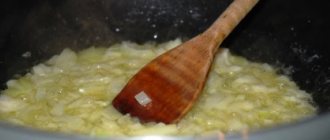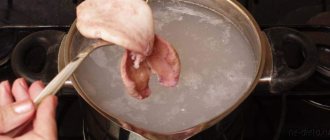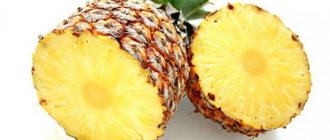How to cut trout before salting?
When choosing fish, you should give preference to a chilled rather than a frozen carcass. This will allow you to carefully examine the trout and understand how fresh it is. When preparing for cutting, you need to choose a sharp knife and a suitable board.
Preparation for the main cutting process includes several stages:
- Moving from the tail to the head, it is necessary to clean the skin of scales and rinse the fish with cool water.
- Cut open the belly and carefully remove the contents, being careful not to tear the intestines.
If there is caviar, put it in a separate container for later salting, and throw away the insides. The film covering the abdominal cavity gives bitterness to ready-made dishes, so it and the remaining blood clots must be removed. Rinse the fish again with water.
Cleaning fresh trout at home
For cleaning you will need:
- salt;
- latex gloves;
- cutting scissors;
- sharp knife with a short handle;
- scaler;
- fishing knife
Although it is quite difficult to cut yourself on the fins and scales of trout, it is better to work with gloves so as not to get your hands dirty. The fish needs to be washed 1-2 times under running cool water to get rid of the mucus covering the carcass. Then let the trout dry for 1–2 minutes: this is enough so that the overdried scales do not fly away in all directions.
To prevent the trout from slipping out of your hands during cleaning, sprinkle it with salt.
Method of cleaning trout with a knife with a short handle
How to remove scales with a fish scaler
- Place the washed and dried fish on a board or in the sink.
Dried and washed trout are cleaned in the sink or on a cutting board. - We take the fish in one hand and the fish scaler in the other.
A fish scaler is convenient for removing trout scales. - We clean the scales with a fish scaler in the direction from the tail to the head.
Scales are removed with a fish scaler, moving the tool against the growth of the plates
Cleaning scales with a fishing knife
- Place fresh fish on a cutting board or in the sink.
- We hold it with one hand, and with the other we take a fishing knife, the upper part of the blade of which has serrations.
- Picking up the scales, we clean them off with a knife, moving from the tail to the head.
When cleaning trout, you can replace the fish scaler with a fork or tablespoon. A tetrahedral kitchen grater also cleans plates well. Small scales can be easily removed with sand or coarse salt: just rub the fish well with them.
How to cut trout: the main stage
Now you need to prepare the carcass for cutting into portions or separating the fillet for salting. The work includes several processes:
- the head and tail need to be cut off and placed in a separate bag; they can be used later for preparing first courses;
- To remove the fins, the flesh on both edges must be cut and the protruding part pulled towards you. The fins located on the abdomen are cut off;
- Finally, remove the skin. To do this, you need to pick up the edge of the skin near the cut where the head was and gently pull it towards the tail.
You need to remove the fillet from the prepared carcass by cutting off the meat from the ridge and removing the remaining bones with tweezers. As a result of this work, you will receive two pieces of red fish fillet that can be salted, as well as a set: head, tail, fins and ridge for preparing first courses.
Cutting whole fish for fish soup and steaks
Salmon species are tasty in any form. For fish soup, you can use only the heads and tails, separating them from the whole carcass after cleaning them from scales. The gills should be cut out from the head, because... Dirt accumulates in them, and the taste and smell of the organs can spoil the dish. All other parts of the head are edible and easy to chew once cooked.
Strips of peritoneum for fish soup can also be cut off from the main carcass, but more often they are left. Classic steaks are made from the gutted carcass (with or without bellies). To do this, a trout carcass with skin and without a head is cut crosswise with a long sharp knife.
The pieces should not be too thin. To make the steaks crispy and juicy, the thickness of the piece should be about 3 cm.
Steaks can also be cut crosswise from whole fillets into wide strips. This way the pieces of meat will be boneless. If there are rib bones left on the fillet, they can be easily removed by prying them together with the film that is in the abdominal part with a thin flexible knife. Then, if desired, you can separate a piece of meat from the skin.
Video: how to cut trout
The proposed option is suitable for salting red fish using dry and wet methods. The finished fillet can be left whole or cut into small pieces. If necessary, the remaining fish can be frozen; this does not affect its taste.
To better understand how trout is cut, watch the video. The workflow may seem complicated, but with practice your movements will become more confident and cleaning the fish will not be difficult.
Many people love red fish. Its meat is tender with a subtle, specific taste. Housewives prefer fresh trout, but if there is a lot of fish or you want a delicacy, you can salt it. Salted trout at home is very tasty, and at the same time retains most of its vitamins and other useful substances. There are many recipes for pickling, it remains to choose the best one.
Features of cleansing
Before proceeding directly to removing the scaly cover of the fish, it is necessary to rinse it under running water. If the trout is quite slippery, you can lightly sprinkle it with salt, so that it will not slip out of your hands.
To clean scales from trout, you need to arm yourself with a short serrated knife. Of course, you can use other improvised means and devices, but it will be easiest to clean the scaly cover with a knife. Scales can be removed both in the direction of its growth and against it. At the end of the process, the trout must be thoroughly rinsed under running water.
The rows of white, pink and red trout meat on the fish stalls are mesmerizing to look at. This amazing fish is loved by both culinary experts and housewives. It has a delicate taste and is suitable for any dish. It is fried, steamed, baked and made into soups. An important advantage of trout is that it is easy to clean and cut at home.
How to choose trout for salting
Trout is an ideal option for salting. You can salt both fresh and frozen fish, the result is the same. Housewives prefer to freeze the carcass first, then the meat becomes pleasantly tender.
It is better to purchase whole carcasses before cutting them in the store:
- • outwardly the fish should appear fresh, just caught;
- • if the tail is dry and the tip is curled, it means the carcass has been stored for a long time;
- • the scales are intact, without damage – if there are any, this is the result of illiterate transportation;
- • the fish itself and its fillet are elastic, after pressing there are no dents left and no liquid is formed;
- • the veins are white, and the fillet has a pleasant delicate shade.
The eyes are clear, not cloudy. It is better to purchase trout from trusted official places. Large stores where there is enough choice and the delivery of goods is regular.
We fillet the whole carcass
- Place the fish on a cutting board.
- We make a cut along the back from head to tail.
To obtain trout fillet, make a cut along the back with a sharp knife. - Use a knife to pry the meat at the base of the head.
- Holding the tool at an angle of approximately 30°, smoothly cut the fillet from head to tail.
Using a knife, cut the meat along with the skin from the ridge - Place half of the carcass, skin on, on the board.
- Remove the bones by cutting them with a sharp knife away from you.
The cut trout fillet is salted and the fish is prepared according to the recipe.
How to cut and fillet trout - video
Cutting fillets for making sushi and snacks
To prepare these dishes you will need pieces of trout. The process of filleting fish and removing the skin is described above, but there is no need to add salt before cutting into pieces, as the fillet will give off juice and become slippery.
How to cut trout for salting
When a whole fish is purchased for salting, it must be cut:
- Rinse the carcass and carefully cut off its fins. It is more convenient to use culinary scissors or the tip of a knife.
- Clean the scales. To make the task easier for yourself, you need to hold the fish for some time under a stream of hot water.
- Cut off the head, then the tail, cut out the gills. Carefully remove the fatty underbelly, it will produce delicious fish soup.
- Cut the carcass, following along the ridge, at the same time removing all the ribs and cutting out the spine.
What remains is the fillet. If there are several fish, they are all cut in the same way.
Didn't manage to cook the dish? Don't be shy, ask me personally.Go
Secrets and tips from cooks and chefs
Most of the recipes are simple and easy to use even for beginners. However, if you want to experiment with the composition, it is worth studying the advice of experienced ones:
- You can't use sour ingredients in pickling. No vinegar, lemon slices or grapefruit. The onion is also superfluous. Everything will spoil, and in addition, it will change the natural taste of the fish. After salting, serve - please.
- It is better to purchase whole carcasses. They are easy to cut at home. At the same time, the housewives receive belly and caviar as a bonus. The first one can be fried or made into a hodgepodge, and the caviar can be salted separately.
- Fresh fish is of course desirable, but frozen will also work. Before using, you need to remove the trout and let it thaw.
- The appetizer will turn out if you patiently wait the time specified in the recipe. Sirloins and portioned steaks are infused for 24 hours. The carcasses are whole, if you salt them like this, without cutting - 2 days.
- Salt is the main component there. Regular iodized one will not work. Better sea or cook. Otherwise, iodine will “take away” precious moisture, drying out the fish.
- If you want to preserve the appetizer longer, you need to keep it in the cold after salting it in its own brine. An alternative is to wrap the steaks in plain paper and refrigerate.
- Before pickling, choose your favorite spices and carefully compose a bouquet. The main thing is that their aroma does not “steal” the taste of the fish.
- The shelf life of such salted trout is 5-6 days. If it is well salted, then 10 days in the refrigerator. Experienced housewives store such a supply in the freezer for a month, taking out portioned pieces at a time.
Homemade brines are a wonderful thing, because housewives use their own, natural ingredients without foreign chemicals. There is no need for them to artificially maintain the taste. In addition, most of the recipes are simple and require affordable ingredients.
Where to add ready-salted trout:
She always adds variety to the table. And it will be useful, especially for children. Some housewives fry their lightly salted trout, adding few spices. You get real main courses.
Useful properties of trout
Before cutting trout and preparing it for further cooking, it is necessary to study all the beneficial properties of this fish. Thanks to them, you can get rid of various diseases and prevent their reappearance. Trout contains a large amount of useful substances (retinol, thiamine, riboflavin, cyanocobalamin, pyridoxine, ascorbic and folic acids), which have a beneficial effect on various body systems.
Useful properties of fish:
- cleanses blood vessels;
- fights Alzheimer's disease;
- has a positive effect on brain function;
- accelerates the process of glucose absorption;
- normalizes metabolism;
- reduces cholesterol levels;
- relieves depression and anxiety;
- has a positive effect on the central nervous system.
- reduces the risk of cardiovascular diseases;
- reduces the risk of developing diabetes.
Description and features of trout
Surely many of you have heard the following fish names at least once: char, brown trout, mykiss, Clark salmon, golden, rainbow, but not everyone knows that these are the names of trout. It belongs to the salmonids and can live in both salt and fresh water. Trout is widespread in almost all mountain reservoirs with clean and cold water.
It tolerates various contaminants very poorly, which makes it difficult to breed for industrial purposes. Trout does not have a permanent color. It often changes depending on environmental factors, food and the time of year. In most individuals, the back has a greenish tint. The rest of the fish is yellowish-green in color with dark round spots. The trout's belly is colored light gray. Trout is not a very large fish.
In most cases, their size does not exceed thirty centimeters, and their weight is 1 kg. However, there are also quite large individuals, whose weight can reach twenty kilograms .
They have pink, white or yellowish colored flesh. River fish are characterized by a lighter shade than sea fish. Meat is rich in various vitamins and microelements. It contains:
All these beneficial substances strengthen the cardiovascular and nervous systems, and also help normalize blood pressure and prevent cancer.
How to clean fish from scales?
To clean trout from scales, you need to perform several preparatory steps. They will help simplify the work and complete it in the shortest possible period of time.
Cleaning fish from scales is done using the following items:
- a special fish knife (with serrations) or a metal brush for washing dishes;
- cutting board;
- paper towels;
- latex gloves.
In most cases, housewives do all dirty work wearing gloves. This helps protect the skin of your hands from the negative effects of various factors.
- The fish is washed thoroughly with cold water. They do this in order to get rid of the mucus that covers the trout.
- After this, take paper towels and use them to get rid of the remaining moisture.
- The fish is sprinkled with salt on all sides. This little trick will help prevent the trout from slipping out of your hands.
- To clean the scales with a sharp knife or a metal brush, start from the tail, gradually moving towards the head. This work must be done as carefully as possible, since the slightest mistake can damage the delicate skin of an aquatic inhabitant.
- Then the trout is turned belly up and all the same steps are repeated as for the side parts of the carcass.
- At the very end, the fish is washed with water and the fingers are checked for missing scales.
Cleaning and gutting
To ensure that the trout does not lose its original shape during the cooking process and does not fall into pieces, it must be properly cleaned. To do the cutting yourself at home, you need to stock up on a plastic board, rubber gloves, a metal dish sponge, a fine grater, salt, a sharp knife or a fish scaler. Moreover, the cutting board should not be made of wood, and should be used exclusively for cutting and cleaning fish. The use of boards intended for cutting bread and vegetables is strictly prohibited.
Before you start cleaning the trout, you need to thoroughly wash it under cool water, trying to remove all the mucus. Then the carcass should be placed on paper towels and excess water should be allowed to drain. Next, to prevent the fish from slipping out of your hands, you need to rub it on all sides with coarse salt, put on gloves and start cleaning. First you need to remove the scales from the fish. A serrated knife or a metal sponge for washing dishes is quite suitable for this. The scales should be peeled in the direction from the tail of the carcass to its head, while trying to act as carefully as possible and not tear the skin.
When removing scales, it is necessary to take into account that the scales on the abdomen are lighter in color and are difficult to see. Therefore, the quality of work must be checked with a finger, and accidentally missed flakes must be removed immediately. Instead of a serrated knife or a metal sponge, you can use a special fish scaler or a fine grater.
The next step in cutting trout will be gutting it. To do this, an even incision is made from the anus to the head, after which all the insides are taken out, the films are removed, the blood is cleaned out with a spoon and the gills are removed. If you plan to cook the dish without the head, then carefully cut it off and throw it away. Then both side fins are cut off and the dorsal fin is completely removed. Next, the fish is thoroughly washed under running water and placed again on a paper towel to remove excess moisture.
Trout cutting process
Cutting fish for salting, frying or preparing soup should also be carried out according to generally accepted rules. Otherwise, you can spoil the appearance of the trout or worsen its taste.
Fillet cutting for salting and frying
To cut trout for salting or frying, you need to fillet the carcass. To do this, you need to know how to separate the ridge and all other bones, and also take into account important nuances of the process. It’s not so easy to do all this, so it’s better to practice on cheaper fish.
The work is carried out as follows:
- The first step is to gut the trout. To do this, make a longitudinal incision in the abdomen and carefully remove all the insides.
- The carcass is placed on a cutting board with its back facing up.
- Using a special knife, a cut is made from the base of the head to the tail.
- Then a transverse cut is made, trying to get as close to the ridge of the fish as possible.
- After this, turn the carcass over and perform similar actions.
- Rib bones are cut from 2 large fillet pieces.
- At the next stage of work, the dorsal and ventral fins are removed.
- Using tweezers, remove all small bones.
- At the very end, the fish is placed on a cutting board and the skin is separated. This is done with a thin and sharpest knife.
Methods for cleaning trout
The method of cleaning trout is chosen depending on the nature of the dish being prepared. In this regard, the order of cutting fish may be changed and some steps may be missed. For example:
- Depending on the cooking method, choose the size of the fish.
- Trout is prepared in a number of ways.
- You can simply fry it in a frying pan.
- Trout makes a very tasty and healthy fish soup.
- Trout can be stuffed with various contents.
- Baked trout, possibly using cream.
Roasting whole trout
To bake whole fish, you should choose fish carcasses of a certain size. The main thing is that it fits on the baking dish. It should be remembered that the larger the fish carcass, the longer it will have to cook.
First of all, you should rinse the fish to remove mucus. As a rule, it is unlikely that you will be able to do this in one go. If you use salt, you can solve the problem of holding fish. Trout can be cleaned in one or the other direction. Particular attention should be paid to cleaning the belly of the fish. Here the scales are smaller, but also more durable than on other parts of the body. If you don't clean the belly well, you can ruin the dish. It is not necessary to cut off the trout's head, just remove the gills. Finally, rinse the fish thoroughly again. After this, it is advisable to dry it with paper towels. Trout is cooked either in the oven or in a slow cooker, depending on the recipe.
Gutting fish
This stage of cutting fish is present, regardless of the cooking method. And you can do it yourself. To do this, you need to cut the belly of the fish, starting from the anal fin to the gills themselves. After this, you need to take out everything that is inside the belly. The film can also be removed. If you don't do this, you may end up with a bitter dish.
Some cleaning tips
If you follow some rules, the process will not be burdensome. For example:
- It is better to clean fish in a sink. This will protect the kitchen from unnecessary dirt and save time on cleaning and cleaning.
- For cleaning fish, a knife with a short handle, but rather sharp, is more suitable.
- If there is no option with a sink, then it is better to cut the fish on a cutting board. At the same time, it is very important that the fish cutting board is not used for preparing other food products, except for cooking meat. This is especially true when bread, cheese, sausages, etc. are cut on a cutting board.
- If you need to put fish in the freezer, you should make sure that there is as little moisture on it as possible.
- It is advisable to clean and cut the fish immediately after purchase. When it is completely defrosted, this technological process will take much longer.
Skinning trout and removing bones
Some cooking methods do not require removal of bones and skin, but if this must be done, then:
- After the fish is cleaned and gutted, only then do they begin to remove the skin and bones. At the same time, the fish must be clean.
- The head, tail and fins are also removed.
- Removal of the ridge with bones is carried out through a longitudinal incision made on the back of the fish.
Not a big tip : to remove the backbone with bones, you need to make a deep cut to divide the fish carcass into two parts. This is the only way to get rid of bones without any problems.
Important: the knife must pass in close proximity to the vertebrae of the fish and follow a sliding path. In this case, you need to control the position of the knife. The knife should go at an angle, towards the abdomen. This process requires holding the fish carcass motionless.
- After this, the remaining bones are removed. They are easy to spot if you run your finger across the meat. They are removed using tweezers or nail scissors.
- To remove the skin from the meat, first make an incision, after which, holding the fish, the meat is cut off from the skin. At the same time, you should also control the position of the knife. It should be at an angle to the table, or rather, at an angle to the skin. This is the only way to properly separate the meat from the skin.
- Similar actions are needed when you need to prepare salad and rolls, as well as those dishes that require small pieces of meat.
How to clean frozen fish?
Working with frozen fish is much easier than working with fresh fish. Because of this, many housewives prefer to put newly purchased trout in the freezer and begin cleaning it only after a few hours.
Process for preparing frozen fish:
- The trout is removed from the freezer and placed in a large container filled with cold water. It is important to remember that it is not recommended to defrost fish or meat in warm or hot water.
- After about 15 minutes, they begin cleaning the carcass. To prevent it from slipping on the cutting board, rub it with coarse salt.
- At the initial stage, the scales are removed. Due to the fact that it is bound by ice crystals, the work is performed as simply as possible.
- After this, the trout is cut in one of the following ways (depending on the dish that will be prepared from the fish).
How to gut
To bake, you do not need to gut the trout whole; you just need to remove the gills. In other cases, the fish is placed on a cutting board and work begins. The process consists of the following steps:
Experienced cooks pay attention: blood from the belly must be removed very carefully so that the finished trout dish does not taste bitter.
Chinese way of gutting fish
In the Middle Kingdom they know how to cut trout in a rather exotic way. The incision is made not along the belly, but across it, in the area of the fin. Then sticks are inserted into the fish’s mouth and pushed deeper. Each stick passes on its side over the gills, pressing them, and is threaded into the hole under the gills. You need to advance the tool until it reaches the cut. After such preliminary preparation, clamp the ends of the sticks from the side of the head, twist them several times like a corkscrew and carefully pull out all the insides along with the gills. All that remains is to thoroughly rinse the trout carcass. To master the process in all its intricacies at home, you can watch a video of how professionals from China do it.
What to do with caviar
If there is caviar in the belly of a trout, you should not neglect the gift of fate. Pickling it is quite simple. The films containing caviar curl up from hot water: therefore, you need to immerse the “bags” with eggs in it and release them directly into the liquid with your hands. Then the caviar is washed and infused in a saline solution. Store the delicacy in a glass jar in the refrigerator.
Some housewives use another method of cleaning: the “bags” are gently rubbed on a coarse grater, as a result the film remains on the surface of the tool, and the eggs are released. You can find many videos online with different methods of preparing caviar for salting.
Fish storage
In order to avoid daily cleaning, gutting and cutting of trout, it is necessary to immediately process all purchased or caught fish. Unused pieces can be frozen and kept refrigerated for several days. To prevent the trout from spoiling during this time, you must adhere to the following rules:
- You can quickly cool cleaned and gutted fish using crushed ice. However, for long-term storage it is better to place the carcasses in the freezer.
- You can increase the shelf life of trout using vegetable oil. They should rub the carcass and put it in the cold. Before cooking, you will definitely need to wash off the protective layer from the surface of the product.
- If a yellowish coating appears on the fish, this indicates the beginning of the rotting process. Meat damaged by microorganisms should be cut off and disposed of, and the rest should be consumed within 24 hours.
- Before placing trout in the freezer, you should dry it with paper towels. This will remove excess moisture, which will shorten the shelf life of the product.
- It is not recommended to store carcasses or fillet pieces open. It is best to wrap them in parchment paper, which will protect the fish from moisture and retain all the substances beneficial to the human body.
- Before long-term storage (more than a week) in the freezer, it is necessary to treat the fish with a saline solution. It is prepared from 1 liter of water and 3 tbsp. l. salt. Thanks to this, it will be possible to slow down the proliferation of harmful microorganisms that can lead to rotting of the fish.
- It is important to keep trout away from milk, sausage and any smoked foods. Otherwise, the shelf life of the fish will be reduced several times.
Trout is one of the healthiest and most delicious fish. To enjoy it and preserve the maximum amount of vitamins, you need to know how to clean and cut up a carcass. If all steps are carried out accurately, even a novice housewife can do this job.
